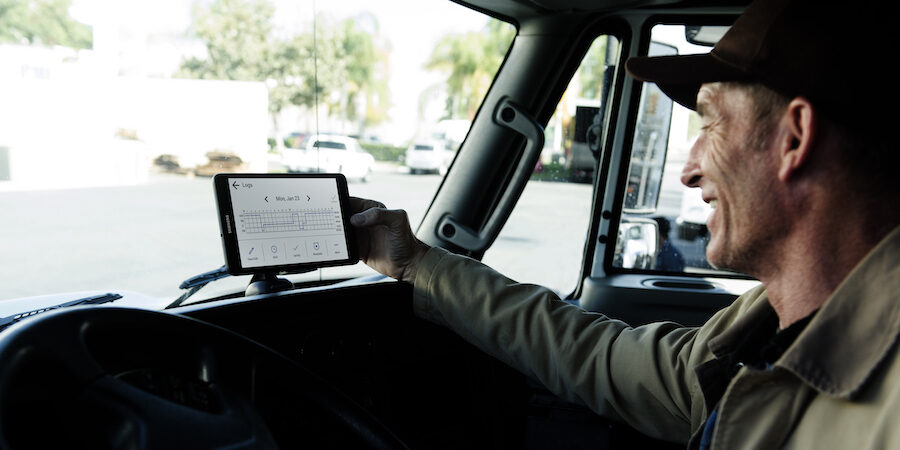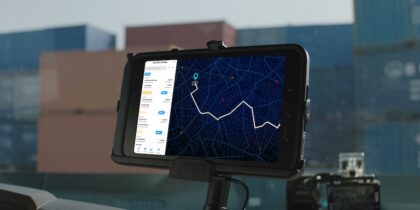Telematics ensures mobile devices in vehicle cabs are now commonplace. These phones and rugged tablets can help fleets distinguish themselves from the pack by leveraging telematics technology that takes a big bite out of waste and boosts profit margins every day.
Every year, trucks end up burning through roughly one billion gallons of fuel as a result of idling, according to the United States Environmental Protection Agency. Additionally, The FMCSA estimates each driver spends an average of 20 hours each year completing paper record of duty status (RODS) logbooks. With in-cab smartphones and tablets linking drivers and dispatchers, trucking fleet management can do away with overspending and improve overall safety.
Here’s a look at 11 benefits that telematics technology can deliver for trucking fleet management.
1. Increase efficiency
Real-time communication coupled with routing apps can divert drivers away from road delays and toward high-priority loads. Adding even a few minutes of driving time to each driver’s daily hours of service (HOS) can boost overall fleet utilization.
2. Improve safety
Driver monitoring often encourages behaviors that align with company and regulatory standards, which can reduce accidents and damage to vehicles and freight.
3. Increase job satisfaction
With electronic logs, drivers have more control over their daily routines, which is one of the top contributors to job satisfaction. The drivers know how much time they have left to work and can better collaborate with dispatchers to meet customer demands. With rugged smartphones and tablets with them at all times, they can engage in training at a time and place that’s convenient for them.
4. Reduce operating costs
Saving even a few minutes of idling time across a fleet leads to huge fuel savings. Better fleet and driver utilization can lift equipment availability to meet customer demand with existing assets. Connecting with drivers via cab-mounted tablets, fleet managers can instantaneously update drivers on detours, reroute them around heavy traffic and direct them to preferred fuel vendors.
5. Monitor safety habits
With connected trucks, management can view how fast vehicles are being driven, how quickly they accelerate from a stop and other indicators of driver behavior. Drivers can be rewarded or counseled based on their performance relative to regulations and standards.
6. Optimize vehicle performance
Vehicle sensors can deliver alerts about engine problems and other diagnostic issues, while informing routing centers when a vehicle is out of service. The cache of vehicle data can help drive fleet overhaul and replacement planning as well.
7. Schedule alerts for repair centers
Wired vehicles can monitor vehicle diagnostics and contact repair centers with proactive schedule alerts. This allows drivers and managers to plan for maintenance rather than running a truck to the point of failure.
8. Streamline compliance
During the 2021 RoadCheck enforcement event, HOS constituted the most cited driver out-of-service violation, coming in at 41.5 percent, which is up from 37.2 percent in 2019. Fleets need to be more proficient with mobile telematics technologies to improve compliance.
9. Attract and retain drivers
Trucking companies face one of the highest turnover rates of any industry. Mobile technology can increase engagement for drivers who often feel disconnected from dispatch and each other by allowing them to virtually attend company meetings, while also improving daily communication with their managers.
How to modernize fleet management
Get your free guide to improving fleet performance and profitability with in-cab mobile technology. Download Now
10. Offer superior driver UX/entertainment
Based on telematics data, drivers can participate in intra-company gamification to incentivize driving efficiencies, or set up reward systems for the drivers who exceed their efficiency and safety goals. They can also use the devices off-duty for movies, games and chatting with family and friends.
11. Enhance security
Storing both company and personal data on mobile devices such as the Samsung Galaxy Tab Active3 or XCover Pro becomes possible with Samsung Knox, which can be leveraged to create secure and separate containers for business applications and data. With this technology, drivers can still use company-issued tablets for entertainment and communication during downtime, without compromising the security of business applications.
In this new world of trucking fleet management, mobile technology has rendered paper records obsolete. The power of data and mobile technology delivers improvements in compliance, driver efficiency and fleet performance.
Ready to use telematics in your fleet? See what connected fleet solutions are available today to help you meet company and driver needs. For more tips, tune into this free webinar on how an ELD implemented on a mobile platform reduces operating costs and improves driver retention.









